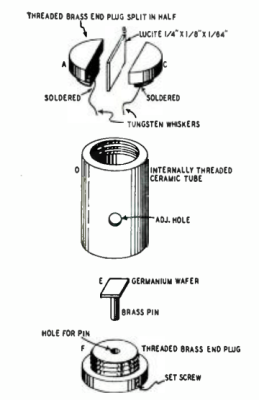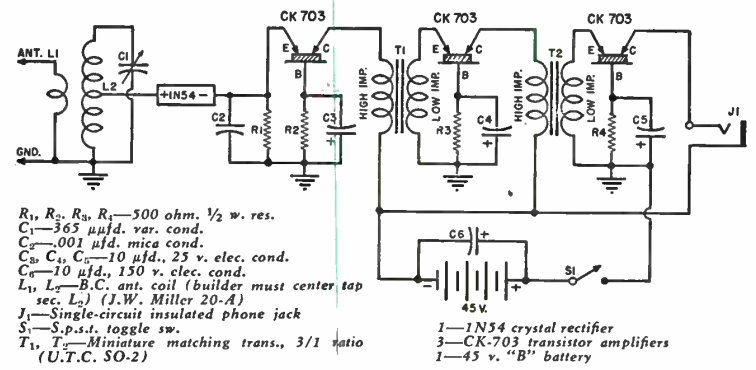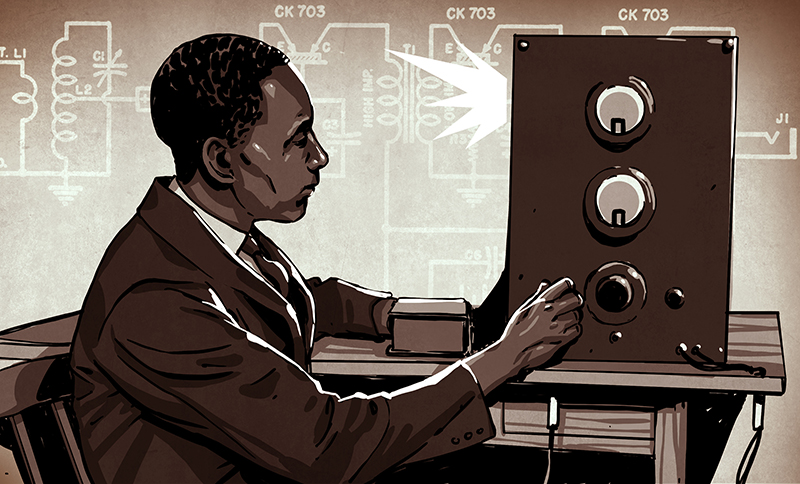It is hard to be remembered in the electronics business. Edison gets a lot of credit, as does Westinghouse and Tesla. In the radio era, many people know Marconi and de Forest (although fewer remember them every year), but less know about Armstrong or Maxwell. In the solid-state age, we tend to remember people like Shockley (even though there were others) and maybe Esaki.
If you knew most or all of those names without looking them up, you are up on your electronics history. But do you know the name Rufus Turner?
W3LF
Turner was born on Christmas Day, 1907 in Houston, Texas. At the age of 15, he became fascinated by crystal diodes and published his first article about radio when he was 17. Rufus Turner was–among other things–the first black licensed radio operator (W3LF). He was building and operating radios in Washington D.C., where he was attending Armstrong Tech.
Turner became a licensed professional engineer in California and Massachusetts. You may have even used something that Turner worked on. In the 1940’s, working with Sylvania, he helped to develop the 1N34A germanium diode (you can still buy these if you look around for them).
Homebrew Transistor

In 1947, industry created germanium transistors, and Turner was among the first to work with them. In 1949–predating commercial availability–Turner published an article “Build a Transistor” in Radio Electronics magazine–the first time most electronic hobbyists had any exposure to this kind of device; you can read the article on page 38 of this PDF reprint. That’s not a typo, by the way. Turner showed how to make a transistor in meticulous detail using germanium, ceramic, brass, and Lucite (see picture to the right).
By 1950, you could buy transistors off the shelf and Radio and Television News published Turner’s “A Crystal Radio Receiver with Transistor Amplifier” (see page 38). This was a three-transistor radio four years before the Regency TR-1 was on the market.
You can see a schematic of Turner’s radio below. The germanium transistors were sometimes refered to as “crystal triodes” and had very poor performance compared to what you’d expect from a transistor today.

The article that describes this circuit is one of the few on practical applications listed in Shockley’s book “Electrons and Holes in Semiconductors.”
Dr. Turner
Turner wrote articles for many years covering hobby and professional topics. He also wrote about technical
writing, math, and other subjects that interested him. In 1958, he earned a BA from California State College and then received an MA in English from USC. By 1960, he was working as an English professor, and became a Ph.D. in 1966. Although he was teaching English, he continued to turn out electronic publications including “ABC’s of Zener Diodes” in 1974 and “ABC’s of Integrated Circuits” in 1977.
Rufus Turner died in 1982, the same year that his “The Illustrated Dictionary of Electronics” went to print. February is black history month in the United States, and I thought it was a good time to remember this prolific author, teacher, and solid state pioneer.















Interesting article. One more amazing person in a long list of people that I need to learn more about.
I wonder if the current holder of the call sign W3LF has any idea of the history behind it.
According to FCC records, that call sign belongs to nobody right now. It had been assigned as recently as 2018.
Good article. You should probably do one about Julius Edgar Lilienfeld as well, he is often omitted when invention of the transistor is discussed.
Intersting
Anybody else see the “Dangerous Surplus” article on page 10 of the PDF??
Just sorta slipped in there no big deal…
holy crap. now i’m going to double check all the old radios I get at swap meets don’t contain tnt…. were there any fatalities from that incident?
Anyone else glad that apple and other companies don’t take the “don;t mod/hack/open/reverse-engineer our (your) products” thing this seriously?
They probably would if it wasn’t illegal.
The fact that it’s military surplus from a time when this technology was new probably also had something to do with it.
Came here to make the same comment, glad I wasn’t the only one who spotted it.
haha how nice spot. that’s crazy!
Nothing like running the risk of having a project blow up in your face…
There are still people that collect and restore those old radios. Could there still be live detonators out there after all this time????
There are few that restore old military radios, most are looking for antique consumer sets particularly those with great cabinetry. When I was a kid those old surplus rigs were one of the ways you could get on the air as an amature radio opperator other than homebrew, but they were not display items.
There are a few that collect entire dioramas of military units http://www.mrca.ar88.net/ We have less than fifteen people regularly in our old radio club meetings, and we have at least three very active military collectors.
Brass capped ceramic tube with cat whiskers? I’m picturing either clear ceramics like spinel for showing off really great workmanship, or the ultimate steampunk DIY transistor to combine with the diodes from http://hackaday.com/2010/03/05/diy-diodes/
Thanks for the article!
It works better if told in the sequence that I experienced it.
Rufus P. Turner was some guy who was a prolific writer for a period in the hobby electronic magazines. When I was about 11, and had worked my way through the “electronic books” in the children’s library (really mostly “electrical books”), I was allowed to take books out of the adult section. One was “Electronic Hobbyist’s Handbook” by Rufus P. Turner, published in 1958, from Gernsback Books. Some chapters on safety, and construction practice, then a whole lot of circuits, including transistors. It seemed to cover all that the world of hobby electronics could, the potential for all those possibilities, at a time when i was about 11 and not only hobby electronics was new, but so was the whole world. I took that book out quite a bit. About a decade ago I found another copy, at a used book sale, for about fifty cents, when hobby electronic books rarely appear at such sales. I was so pleased, a familiar book from my childhood, I made space for it on the shelves of technical books.
He wrote a lot about transistors in the magazines, so I assumed he was a relative newcomer. A lot of people never made the transition from tubes to transistors, but he was very interested. As I came across his articles in back issues, I don’t think I remembered that he’d written that book from the library.
His name was very common, I have a book about test equipment he wrote (also from a used book sale).
And then maybe five years ago, I was looking at a digitized “Radio Handbook” from about 1936, and there was his name in the acknowledgements, I’m not sure I’d known he was a ham, I certainly hadn’t thought he’d “been around the hobby that long”.
So I was curious. In the old days, all we knew about the prolific writers in the hobby electronic and ham magazines were what they wrote. We knew nothing about their lives, and they didn’t print photos of the authors. We didn’t know if they spent their time building projects and writing them up, or if they had a “day job”. We just knew that some wrote a lot more than others.
And when I looked him up, I saw he was black. A big surprise, since in the context of the hobby magazines, we’d have never known. This really familiar name, author of that book that I can pull out and just travel back to my childhood, he was black. A bit of news that pleases me for some reason. But it also made me think of his world. He didn’t get to be a role model because the color of his skin was invisible to us, but he was able to be out in the world in a way that many black people at the time weren’t able to, since writing made his skin invisible.
And he wasn’t a minor character. The same search told me about his work with the 1N34. Even to this day, if someone is specifying a small signal germanium diode, they’ll specify “1N34” in a generic sense. You know that you need a small signal germanium diode, and likely that’s because the low voltage drop across the junction is needed.
The world that he lived through, amateur radio when it was still young, yet equal to the famous writers for the amateur radio magazines in the thirties, then straddling into the solid state era, teaching us about it when it was still new. I’m sure he’d be happy to see some recognition all these years after his death, he was more than a name in the hobby magazines.
.
He was one of us.
Michael
Hear, hear!
Beautifully written, the more I look into Rufus Turner the more impressed I find myself. Thanks HAD for introducing me to him!
This great article about Rufus. I was the youngest Black in KY to be license at 16 years old Novice WN4ETV in 1960 then General WA4SWF in 1963 and now Extra. I called the KY Traffic Net for 4 years and worked the KY-CW net for many years and still do today. Fred Jones WA4SWF, Louisa, KY
Thank you so much, to my friend Carole, for bringing this important bit of history about Mr. Turner to my attention. Grateful for this article and grateful to you, Michael for your research and comments.
Thank you Rufus Turner for hanging in there and being you.
Della KD2NAP
It’s hard to imagine how much of an effect his efforts had on our modern world. I hope hackerspaces start hanging paintings of guys like this.
To be honest my interests in the state of the art largely parallels Mr, Black. I somehow managed to read all of those books in my library’s children’s department. Then also was allowed to take out what they had in that department. Every so often find those he wrote and read them again and again.
I am (still) impressed by his work. By the way Gernsback publishing is the same name behind the Hugo in Sci-Fi. And all of what we do came from there. Except for a few…..
And Al? Take a bow. I knew who all of them were, right off. But does anyone know what Esaki invented? That’s the prize worth its weight in a certain form of crystals.
Esaki invented the Esaki diode, One time I found a heavy portable am/fm radio made by Sony, and it says right on the front that it has an Esaki diode inside.
But that was later. Tunnel diodes came along in the early sixties, they had some value(I gather some Tektronix scopes use them in the trigger circuitry) but for hobby circles, they were mostly a novelty. They’d run off 1.5V, and there were interesting circuits travelling about, like in the GE semiconductor handbook where the tunnel diode is used as an oscillator/mixer that converts the FM broadcast band down to an RC coupled 200KHz IF strip followed by a pulse counting detector. Some of the novelty was that it could oscillate and mix at the same time, but so could any old transistor. But for a decade they’d bounce around the hobby magazines, something new but nobody really doing anything practical with them. They were rapidly replaced by other new devices coming along that did things better. There was nothing a tunnel diode could do that other semiconductor devices couldn’t, though maybe at the time of invention they may have done better at higher frequencies.
It was amusing twenty years ago to see people asking on the internet where to get a tunnel diode, they’d found a circuit somewhere but no context telling them that tunnel diodes shone brightly for a brief time, and then pretty much disappeared.
And an Esaki diode is a tunnel diode, though I didn’t learn that until later. The common name in North America was “tunnel diode”.
Michael
+1
Thanks for the explanation Michael; much like some others above, I was that kid who went through all the books in the kids section of the library. Back in the 70s, a lot of the books still had valves (tubes) in the projects, not much use to me. And of course, the occasional mention of this almost mythical thing called a tunnel diode. (I seem to recall it was used in a transmitter circuit)
The Esaki diode was widely used in UHF TV tuners as the oscillator/mixer because their low capacitance made oscillation easier at those high frequencies, where tubes and transistors faded to little or nothing. While I owned and played with an Esaki/tunnel diode back in the 60’s, I wish I had known about them in the tuners, I could have quite a collection by now. My next side-project is planned to be “lamda diodes”, two interconnected transistors that act like Esaki/tunnel diodes. Look it up before it disappears off the internet.
Another little known Black American inventor was Granville T Woods. In the late 19th century he invented a railway 2-way wireless communications system that used an magnetic-induction coil suspended below the train to interface with another MI induction coil along the track. It was a hybrid voice and telegraph system. Later Edison bought all the rights and Granville was marginalized in US history. FYI he was NOT an Australian as depicted. That was just a clever cover story invented by Granville to not be marginalized as being an Africa-American during those racist days.
James E. West.
Minor invention…
The electret microphone.
Garrett Morgan was another black inventor known for his gas mask (specifically for fire fighters) and his traffic signal.
Sidenote: He was also from Cleveland Ohio.
I wonder why the comments are infinitely more civil than I thought they would be?
Maybe because HaD didn’t explicitly state the fact that he was black and just showed that in the illustration.
Not that I would find much of a problem if they did. I was sincerely asking that question.
Well, I’m not sure how much clearer it could be:
>among other things–the first black licensed radio operator (W3LF).
Wow – those old magazines had a ton of articles in them!
TL;dr
How many Pi Zero hubs or arduino blinkers were in there?
Only 2 each. Didn’t you see them? No? You should go back and look again. Don’t come back until you find them!
Yep. Those were the days before endless advertisements. Back when children ^ knew their place and couldn’t get their 2 cents in just because they can.
Have you read them? Packed full of advertisements!
If you read the article you’ll realize how much of a hack this is. The steps to build the transistor are:
1) Take two 1N34 diodes, poke out the sealing hole and carefully melt out the wax.
2) Unscrew the end caps from the ceramic tube body of the 1N34 and unsolder the tungsten whisker from two of the endcaps.
3) Saw one of the end caps in half (literal hacking!) and piece it back together with a whisker on each half and a thin piece of plexiglass or lucite as an insulator
4) Reassemble this into the body of the 1N34 as a two-junction device
5) Adjust the gap between the whiskers
6) Seal the tube with scotch tape (no wax)
That is some seriously hard-core hacking to get one transistor.
Probably one of the few writers who’s works, at different times, would interest both my father and my mother.
I have been a ham for 56 years plus and this is the first I have read about this ham>
I hold Mr.Turners Mass. call sign and I am looking for any and all qsl cards from him.The calls are K6AI,1AY/W1AY and also W3LF .Any and other info would be appreciated as I wish to write a history on Rufus Paul Turner.
73,
Brad w1ay
Is this post worth putting in the Biography category?